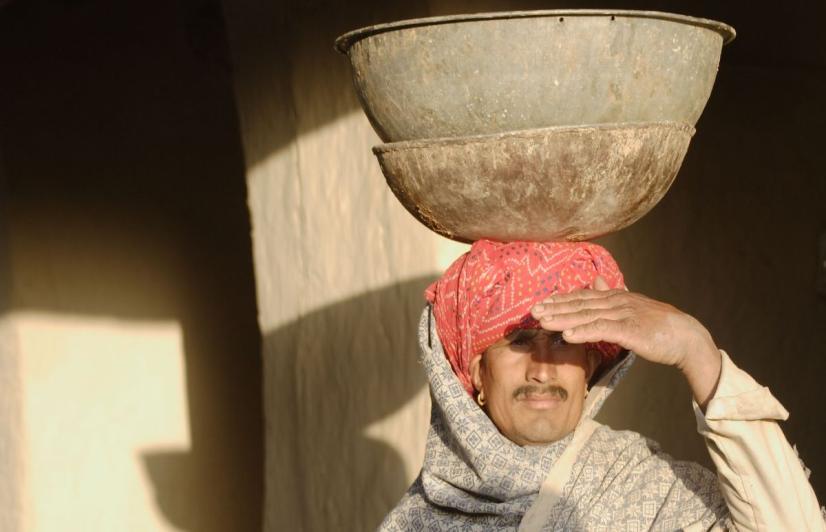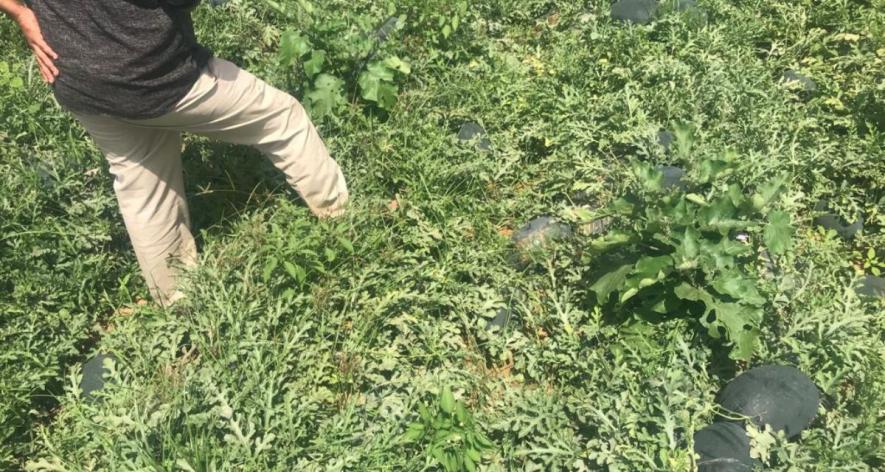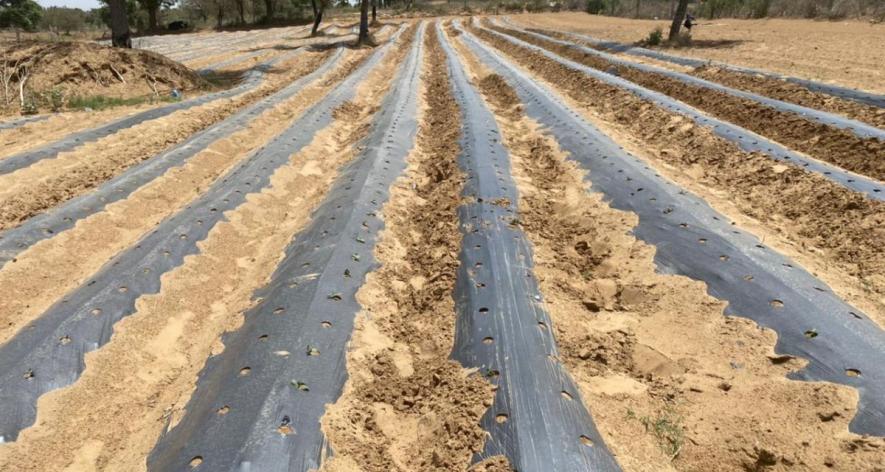Rajasthan: Farmer Gains, Soil Loses as Lease System Picks up Pace in Shekhawati Region

Sikar: From the time they wake up from sleep till they go to bed at the end of the day, they are on work in the farms taken on lease. They hardly know the villagers except for their lessors nor keep track of local developments. Probably, the only person they connect with is the shopkeeper who loans them groceries. The farm owners are the guarantor in this arrangement, and the lessees later pay a lump sum.
The farm is where their hearth and home are. Most of them are labourers from Uttar Pradesh. Earlier, they had to wait for the season for work and wages and had to migrate from village to village. But now, they have a better option in the form of leasing. In Rajasthan’s Shekhawati region, comprising parts of Sikar, Jhunjhunu and Churu, a pucca (Concrete) house with an electric motor connection is present in almost every field.
The lessees stay on the leased plot itself. They take their family along and mostly move to new plots or villages every two years. The family builds an additional structure close to the pucca building if need be. Most of the kitchen work is done in the open, while some make tents during the rainy season. Children of such families do not go to school. They are engaged in family work on the farm itself.
Lease farming not only gives labourers an opportunity to earn better but also instils a sense of ownership in them. “The goal of a lease farmer is to generate maximum production. Vegetables definitely give about three times the profit of grains,” points out Santosh Singh (38), who is into lease farming in Jerthi village of Sikar district.
“Six quintals of wheat is what we get from one bigha, which translates to Rs 13,000 for the farmer. However, watermelon grown on the same plot can be sold for Rs 5 per kg. On average, we can make Rs 40,000 from a single crop,” he elaborates.
Earlier, cereal grains were cultivated twice a year in Jerthi. However, low profit and high seasonal risks proved a hurdle. “We take up vegetable cultivation thrice a year. The water requirements for vegetables are equal to that of wheat, but the effort is definitely less. The whole family works to meet the labour requirements,” says Santosh, who hails from the Agra district in Uttar Pradesh and has been doing lease farming for the last eight years.
Not all vegetables are part of their scheme of things. Gourd, pumpkin and watermelon are preferred as they give yields quickly. The lessees first prepare the land by adding fertilisers and other mixtures. Mud walls are made, on which a drip irrigation system is laid. Tube wells are the main source of water here. Though the water table has been depleting, drip irrigation has reduced its severity to a big extent.
How does it matter?
Traditional crops such as wheat, gram, barley, mustard, millet and mung (green gram) are fading away. About 15 farms are on lease in Kolida village now, against the five plots two years ago. These numbers have been increasing with every passing year. The fields that once remained empty in summers spot fresh, green vegetables. Before the season of one vegetable ends, another is sown.

A leased farm in Bidodi village where the watermelons are ripe and ready to go to the market (Photo - Sandeep Kumar Meel, 101Reporters)
Most of the lessors do not prioritise farming as they have government jobs, do small businesses or own shops. According to a 2017 report by the Ministry of Labour and Employment, only 9.05% of rural households in Rajasthan benefit from government jobs. Among the districts, Jhunjhunu has the highest number of such households at 22.29%, while Sikar stands second at 16.24%.
The lessees have a free hand when it comes to cultivation. They are more inclined to use fertilisers and pesticides as their aim is to make the most out of the crop. Suraj Maurya (27) from Agra tells 101Reporters that about half of this entire income is spent on paying the owner and buying farm medicines. “For every bigha of land, medicines costing Rs 25,000 are required. We can make a profit only if our vegetables get very good prices in the market. We do well in the summers due to the wedding season,” he says.
Hailing from the Shahjahanpur district of Uttar Pradesh, Naseem's family has taken three farms on lease in Jogiyon Ka Bas village in the Sikar district. He has been into lease farming for the last four years and now delivers vegetables to Hisar in Haryana by hiring a pickup. “I spend Rs 60,000 on every bigha of land and manage to make up to Rs 1 lakh from it.”
Farms measuring less than 20 bighas are not popular among lessees as taking them will lead to losses. With the rise in population, the average holding has come down to 15 to 20 bighas in Sikar. According to the Economic Review of Rajasthan, 2022-23, the average holding size of the state is 3.05 hectares (one hectare is equal to 3.95 bighas). In Sikar, marginal farmers account for 67% of the landowners. They own 36% of the total area.
According to Ranglal of Kolida, on average, 1-2% of farms in the surrounding villages are given on lease. Jerthi's farmer Nathu Singh adds that more people are taking land on lease with each passing year, but the number of lessors has not seen a big change. This has had an impact on the annual rental amount too. “Last year, Rs 4,000 to 5,000 was the lease amount per bigha. This year, it has jumped to Rs 6,000 to 7,000,” he says.
The construction of a vegetable market in Nawalgarh and an onion market in Rashidpura is believed to have contributed to the rise in demand for plots and the lease amounts. The new markets have ensured the trade of vegetables from here to Haryana and Delhi.
Weather vagaries have contributed immensely to lease farming. Mustard and gram were widely destroyed in frost this winter. Hail caused havoc at the time of crop ripening. Due to excessive rainfall, several diseases have been affecting the roots of traditional crops. Additionally, farmers are unsure about when to sow the crop due to the change in weather. By giving land on lease, they also save on farm wages and ploughing of fields.

A leased field in Kolida village with a drip irrigation system. The vegetables sown here will be ready during the monsoon (Photo - Sandeep Kumar Meel, 101Reporters)
Two sides of the same coin
What is the impact of lease farming on the land? Some think it has negative effects, while others do not concur. Ajit Singh, Assistant Director, Agriculture Department, Sikar, tells 101Reporters that excessive use of pesticides destroys land fertility. However, the department had no data or study to show if that was the case in the district. It's worth noting the use of chemicals in the cultivation is particularly pervasive, not only during the growing season but also post-harvest.
Satpal Bhaskar, a teacher from Bidodi, attests that productivity has increased after he leased out his land for two years. On this, Ajit says ample application of animal manure could have cured the land of deficiencies.
Meanwhile, Amarjeet of Rashidpura claims the yield has been decreasing. “By the time the lease period ends, the farm is completely spoiled. Weeds swarm them as they are not ploughed, and farmers take at least two years to remove them fully. Once the land is given on lease, the farmer does not give it again because they have more work afterwards. A white layer gets frozen on the ground due to pesticide overuse, and even grass does not grow there,” he says.
Tarachand, a farmer from Kudan, asserts that the land given on lease can be identified easily. “The colour of the land here is light red, which turns completely white once it is on lease. Anyway, the problem of fluoride already exists in this area, and it is increasing. The land has got so used to pesticides that no grain comes out of it without using chemical fertilisers,” he laments.
There has been a lot of bad publicity in the villages about the chemicals used on vegetables in lease farms. Locals do not buy from these farms. Ramprakash, a shopkeeper from Kolida, says he buys vegetables for sale from Nawalgarh market. However, he does not answer the question that even in the market, the vegetables go from the leased fields only.
On the overuse of chemical fertilisers, Omprakash Mattoo, Deputy Director, Agriculture Department, Nagaur, tells 101 Reporters that agricultural scientists recommend the application of only a certain amount of chemical fertilisers to the land, based on research findings. “However, farmers apply them at will, which harms both soil and human beings. This is happening the most in the case of vegetables,” he says.
The practice reduces soil fertility as chemical fertilisers are basically heavy metals, which reduce the amount of organic matter in the topsoil. “It can increase the temperature of the upper layer and also contribute to global warming,” Mattoo explains.
(Sandeep Kumar Meel is a Rajasthan-based freelance journalist and a member of 101Reporters, a pan India network of grassroots reporters)
Get the latest reports & analysis with people's perspective on Protests, movements & deep analytical videos, discussions of the current affairs in your Telegram app. Subscribe to NewsClick's Telegram channel & get Real-Time updates on stories, as they get published on our website.
























